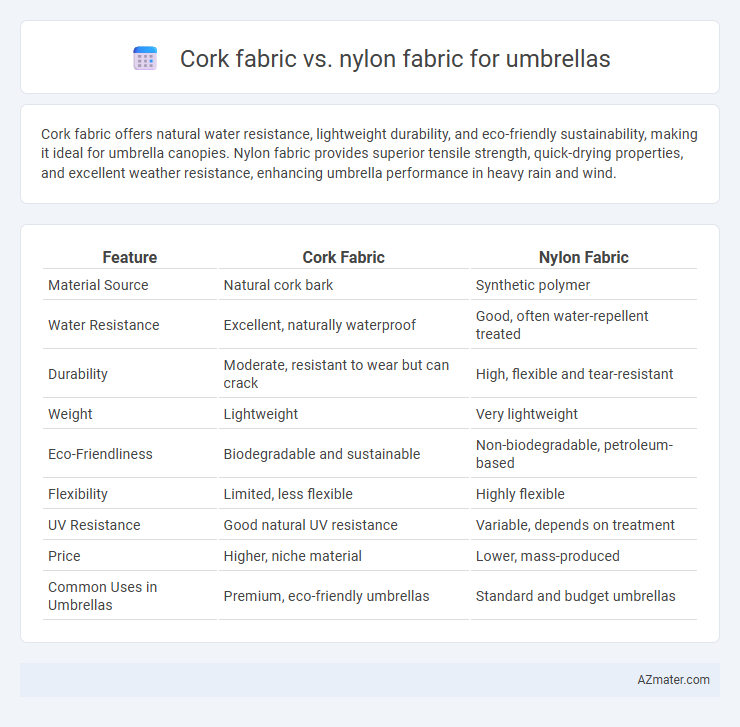Cork fabric offers natural water resistance, lightweight durability, and eco-friendly sustainability, making it ideal for umbrella canopies. Nylon fabric provides superior tensile strength, quick-drying properties, and excellent weather resistance, enhancing umbrella performance in heavy rain and wind.
Table of Comparison
| Feature | Cork Fabric | Nylon Fabric |
|---|---|---|
| Material Source | Natural cork bark | Synthetic polymer |
| Water Resistance | Excellent, naturally waterproof | Good, often water-repellent treated |
| Durability | Moderate, resistant to wear but can crack | High, flexible and tear-resistant |
| Weight | Lightweight | Very lightweight |
| Eco-Friendliness | Biodegradable and sustainable | Non-biodegradable, petroleum-based |
| Flexibility | Limited, less flexible | Highly flexible |
| UV Resistance | Good natural UV resistance | Variable, depends on treatment |
| Price | Higher, niche material | Lower, mass-produced |
| Common Uses in Umbrellas | Premium, eco-friendly umbrellas | Standard and budget umbrellas |
Introduction to Cork and Nylon Fabrics
Cork fabric, derived from natural cork oak bark, offers exceptional water resistance, sustainability, and lightweight durability, making it an eco-friendly choice for umbrella covers. Nylon fabric, a synthetic polymer, is known for its high tensile strength, abrasion resistance, and quick-drying properties, providing robust protection against rain and wind. Both materials excel in outdoor applications, but cork fabric promotes biodegradability while nylon emphasizes performance and longevity.
Overview of Umbrella Fabric Requirements
Umbrella fabric requires water resistance, durability, UV protection, and lightweight properties for optimal performance. Cork fabric offers natural water repellency, eco-friendliness, and a unique textured appearance, while nylon fabric provides superior strength, quick drying, and excellent resistance to wear and tear. Both materials meet essential criteria but differ in environmental impact and tactile qualities crucial for umbrella manufacturing.
Durability Comparison: Cork vs Nylon
Cork fabric offers natural resistance to wear and tear, making it highly durable for umbrella canopies, especially in resisting moisture and UV damage. Nylon fabric demonstrates exceptional tensile strength and elasticity, providing robustness against strong winds and repeated folding. While nylon is more abrasion-resistant and quicker to dry, cork stands out for its eco-friendly durability and natural resistance to mildew.
Water Resistance and Weatherproof Qualities
Cork fabric offers excellent natural water resistance due to its dense cellular structure, making it highly effective in repelling water and preventing moisture absorption in umbrellas. Nylon fabric, commonly used for umbrellas, features synthetic fibers treated with waterproof coatings that enhance its water resistance and durability in rainy conditions. Both fabrics provide weatherproof qualities, but cork's eco-friendly, breathable nature gives it superior resistance to mildew and UV damage compared to conventional nylon.
Environmental Impact and Sustainability
Cork fabric is highly sustainable and environmentally friendly due to its renewable harvesting from cork oak trees, which promotes forest conservation and carbon sequestration. Nylon fabric, derived from petrochemicals, has a higher environmental impact because it is non-biodegradable and energy-intensive to produce, contributing to greenhouse gas emissions and microplastic pollution. Choosing cork fabric over nylon for umbrellas supports eco-friendly practices by reducing carbon footprints and promoting biodegradable materials.
Weight and Portability Considerations
Cork fabric offers a lightweight and eco-friendly option for umbrellas, significantly reducing overall carrying weight compared to traditional materials. Nylon fabric, known for its durability and water-resistant properties, remains lightweight but often incorporates additional coatings that can add slight weight. For enhanced portability, cork fabric umbrellas provide a natural, ultralight feel, while nylon umbrellas balance minimal weight with robust protection against weather elements.
Aesthetic Appeal and Design Flexibility
Cork fabric offers a distinctive, natural aesthetic with unique texture patterns that enhance the visual appeal of umbrellas, appealing to eco-conscious consumers seeking sustainable style. Nylon fabric provides a sleek, smooth finish available in a wide array of colors and prints, allowing for versatile and vibrant design customization. The flexibility of nylon supports intricate patterns and bold designs, while cork fabric emphasizes a rustic, organic look with limited color variations.
Maintenance and Cleaning Ease
Cork fabric used in umbrellas offers natural water resistance and requires minimal maintenance, needing only occasional wiping with a damp cloth to clean dirt and debris. Nylon fabric is more prone to water absorption and dirt buildup, necessitating regular washing and thorough drying to prevent mold and mildew growth. Both materials benefit from air drying, but cork's inherent antimicrobial properties provide an advantage in ease of cleaning and long-term upkeep.
Cost and Long-Term Value
Cork fabric for umbrellas offers a unique natural aesthetic and exceptional water resistance, typically costing more upfront than nylon due to its sustainable sourcing and craftsmanship. Nylon fabric provides a budget-friendly option with excellent durability and quick-drying properties, commonly used in mass-produced umbrellas but may degrade faster under prolonged UV exposure. Investing in cork fabric umbrellas often results in better long-term value through enhanced longevity and eco-friendliness, while nylon is suitable for cost-conscious buyers seeking lightweight and practical protection.
Conclusion: Choosing the Right Fabric for Your Umbrella
Cork fabric offers exceptional water resistance, natural durability, and eco-friendly properties, making it ideal for sustainable umbrella designs. Nylon fabric provides superior lightweight strength, quick drying, and excellent flexibility, ensuring reliable performance in heavy rain and wind. Selecting between cork and nylon depends on whether you prioritize environmental benefits and natural aesthetics or enhanced durability and weather resilience for your umbrella.

Infographic: Cork fabric vs Nylon fabric for Umbrella
 azmater.com
azmater.com